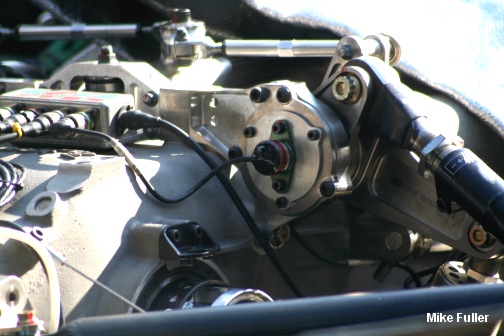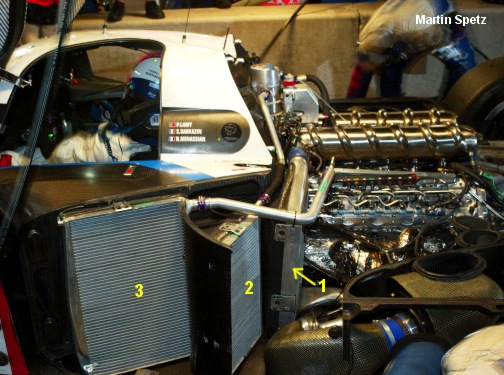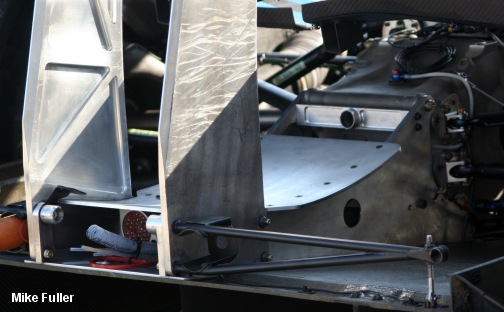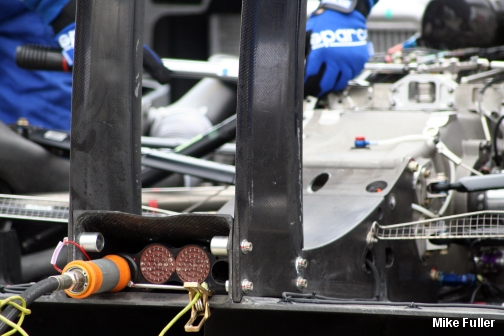 The
908's rear end packaging is conventional with no (as expected)
surprises.
The
908's rear end packaging is conventional with no (as expected)
surprises.  At
the rear, pushrods operate torsion bars. A bell crank
connected to
the torsion pivot actuates the primary dampers which are mounted
vertically
either side of the gearbox. Roll and pitch is apparently
handled
by the T-pivot which is located on of top the gearbox/bellhousing and
receives
input from the same rocker as the damper.
At
the rear, pushrods operate torsion bars. A bell crank
connected to
the torsion pivot actuates the primary dampers which are mounted
vertically
either side of the gearbox. Roll and pitch is apparently
handled
by the T-pivot which is located on of top the gearbox/bellhousing and
receives
input from the same rocker as the damper.
We can also observe that the rear damper is running a high motion ratio. The benefits of this are higher shock velocities which in turn allows for more consistent dampening.
 A
metal "shaft" looking very much like a anti-roll bar type spring blade,
sprouts from the top of the T-pivot and is connected to the front of
the
bellhousing. It would appear that the structure in which the
T-pivot
mounts also has provisions to move, hence the spring blade.
Note
there are provisions for a second shaft to be mounted (to the left of
the
one pictured) allowing for the possibility of doubling one's spring
rate.
Given the orientation of the spring blade, it would appear to be set to
full-soft, assuming left and right movement potential. For
now packaging
seems the primary motivator for this solution.
A
metal "shaft" looking very much like a anti-roll bar type spring blade,
sprouts from the top of the T-pivot and is connected to the front of
the
bellhousing. It would appear that the structure in which the
T-pivot
mounts also has provisions to move, hence the spring blade.
Note
there are provisions for a second shaft to be mounted (to the left of
the
one pictured) allowing for the possibility of doubling one's spring
rate.
Given the orientation of the spring blade, it would appear to be set to
full-soft, assuming left and right movement potential. For
now packaging
seems the primary motivator for this solution. Rotational
potentiometers measure angluar displacement of the torsion
bar/bellcrank. You can just see the load cells as the
heatshrink
enclosed (frankly looks like a round of black electritcal tape) item
just below the top of the pushrod where it locates to the bellcrank.
Rotational
potentiometers measure angluar displacement of the torsion
bar/bellcrank. You can just see the load cells as the
heatshrink
enclosed (frankly looks like a round of black electritcal tape) item
just below the top of the pushrod where it locates to the bellcrank. The
radiator/cooler arrangement has the turbo intercoolers inboard (1), the
oil coolers (2) next as we move outboard, and the water coolers (3) the
furthest outboard. The water coolers exhaust out the vents in
the
vertical face of the sidepod. Note the aluminum intake
plenums here.
The
radiator/cooler arrangement has the turbo intercoolers inboard (1), the
oil coolers (2) next as we move outboard, and the water coolers (3) the
furthest outboard. The water coolers exhaust out the vents in
the
vertical face of the sidepod. Note the aluminum intake
plenums here. By
Silverstone 2008 (though possibly earlier and shown here at Petit Le Mans that same year)
the 908 appeared with carbon
engine inlet plenums. And
courtesy of an article in Race Engine Technology (and brought to our
attention by François Terrien) we have a better idea of the
purpose of the longitudinal swirls. They are evidently a
continuation
of the intake trumpet. At the tangency between the round plenum and
the
trumpet, the trumpet continues to rotate around the plenum in a helical
fashion,
through approximately 270 degrees, instead of dead ending
perpendicularly into it. This allows for a much longer intake
trumpet without the need to raise the height of the plenum to
accommodate taller intake trumpets (thus keeping the trailing edge of
the engine cover that much lower).
By
Silverstone 2008 (though possibly earlier and shown here at Petit Le Mans that same year)
the 908 appeared with carbon
engine inlet plenums. And
courtesy of an article in Race Engine Technology (and brought to our
attention by François Terrien) we have a better idea of the
purpose of the longitudinal swirls. They are evidently a
continuation
of the intake trumpet. At the tangency between the round plenum and
the
trumpet, the trumpet continues to rotate around the plenum in a helical
fashion,
through approximately 270 degrees, instead of dead ending
perpendicularly into it. This allows for a much longer intake
trumpet without the need to raise the height of the plenum to
accommodate taller intake trumpets (thus keeping the trailing edge of
the engine cover that much lower).  The
rear wing pylons are attached to the rear end structure which is
interesting
for its obvious beefy aluminum construction. Similar items on
the
Audi R10 (rear wing pylons and rear end structure) are manufactured out
of carbon. Seen here on the 908 at Sebring in 2008, these
items appeared to be first iterations,
even a year into the project.
The
rear wing pylons are attached to the rear end structure which is
interesting
for its obvious beefy aluminum construction. Similar items on
the
Audi R10 (rear wing pylons and rear end structure) are manufactured out
of carbon. Seen here on the 908 at Sebring in 2008, these
items appeared to be first iterations,
even a year into the project. By
mid-season 2008 (Petit Le Mans here) the rear wing mounts and crash
structure had morphed into carbon fiber versions.
By
mid-season 2008 (Petit Le Mans here) the rear wing mounts and crash
structure had morphed into carbon fiber versions.